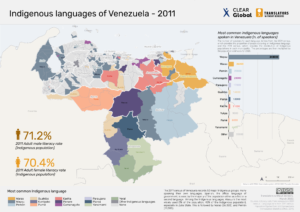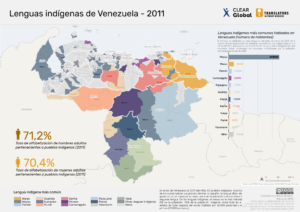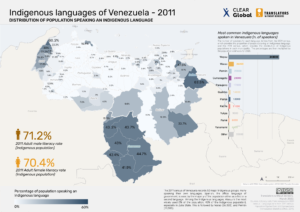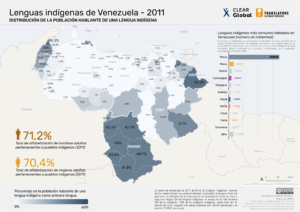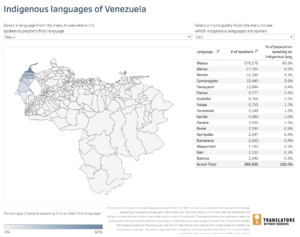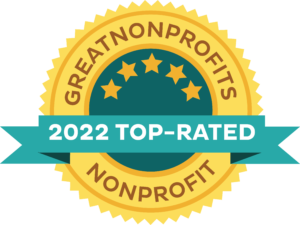The 2011 census of Venezuela records 50 major Indigenous groups, many speaking their own languages. Spanish, the official language of government, is used by the majority of the population either as a first or a second language – although no precise figures exist. All languages spoken by the Indigenous people of Venezuela are also recognized as official languages. The census states that Wayuu is the most widely used of the Indigenous languages (1% of the population, or just over 348,000 people), especially in Zulia State. This is followed by Warao (36,000), widely used in Delta Amacuro State, and Pemón (22,000), concentrated in Bolívar State. Even smaller Indigenous languages are the main language in some municipalities. These include Piaroa (13,000 speakers) and Yanomami (6,000), widely used by isolated groups in Amazonas State.
In urban areas of the country, especially the coastal region near Caracas, most people speak only Spanish. Indigenous languages are more commonly spoken in rural areas. The exception is the city of Maracaibo in Zulia State, where as much as 60% of the population in some municipalities speak Indigenous languages.
As the most recent census to record Indigenous language use dates back to 2001, we consulted civil society, academics and linguists from several Indigenous communities on the current situation. With their help, we have taken the unusual step of combining data from the two most recent censuses to provide the most accurate and up-to-date picture of Indigenous language use in Venezuela. The number of speakers for each language derives from two different variables from the 2001 and 2011 censuses: the 2001 census provides the proportion of people speaking an Indigenous language in each state, and the 2011 census provides the distribution of Indigenous populations in each municipality. We have combined these proportions, making the assumption that people who reported speaking an Indigenous language primarily speak the language associated with their Indigenous group, and not taking into account people who might speak more than one Indigenous language. We then multiplied the percentages by the population estimates for 2020, provided by the Venezuelan Statistics Office.
In 2011, literacy rates among Indigenous language speakers were lower than for the population of Venezuela as a whole. Just 71.2% of men and 70.4% of women were literate in Indigenous communities, against 95% of men and 98% of women nationally.
Among members of Indigenous communities, the Waikeri, the Baré, the Baniwa and the Kumanagoto have the highest literacy rates, all above 85%. The Sanemás, Yanomamis and Arawaks have the lowest average literacy rates, all below 35%.
Explore the data by municipality here.
Curated datasets
Available on Humanitarian Data Exchange (HDX)
Other sources of language data
Ethnologue
Glottolog
For more information, please contact maps@translatorswithoutborders.org
Maps and resources:
Indigenous Languages of Venezuela - 2011: Static (EN)
Static map highlighting the most common Indigenous languages spoken in Venezuela. Data is from the 2011 and 2001 censuses.
Lenguas indígenas de Venezuela - 2011: Static (ES)
Static map highlighting the most common Indigenous languages spoken in Venezuela. Data is from the 2011 and 2001 censuses.
Distribution of Indigenous languages speakers in Venezuela - 2011: Static (EN)
Static map highlighting the distribution of people speaking an Indigenous language in Venezuela. Data is from the 2011 and 2001 censuses.
Distribución de la población hablante de una lengua indígena - 2011: Static (ES)
Static map highlighting the distribution of people speaking an Indigenous language in Venezuela. Data is from the 2011 and 2001 censuses.
Languages of Venezuela: Interactive (EN)
Interactive map showing the number of speakers and geographic spread of different Indigenous languages in Venezuela. Data is from the 2011 and 2001 censuses.
